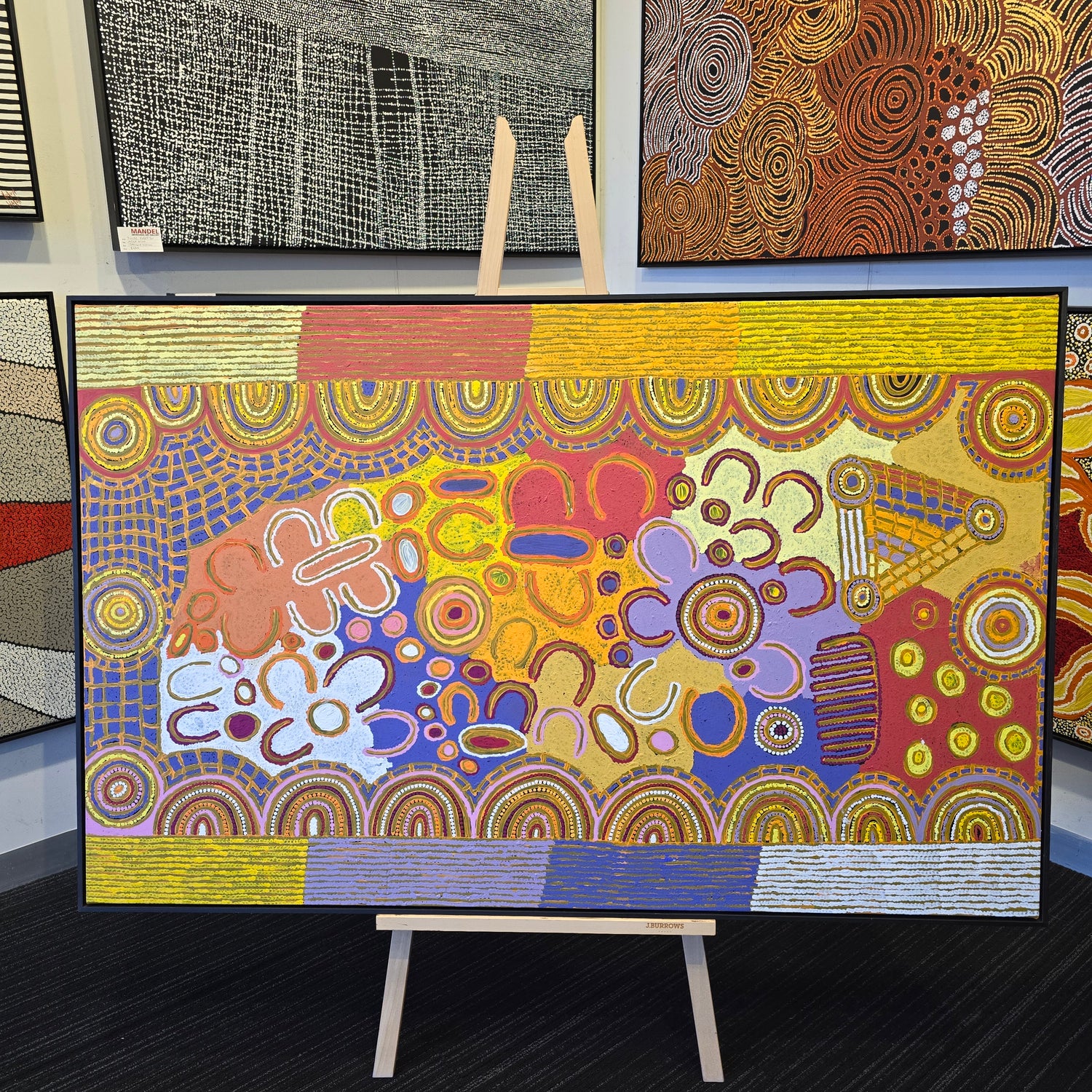Collection: Joy Maxwell Nampitjinpa
-
 Sold out
Sold outJoy Maxwell 960 mm x 1520 mm
CODE : 5326Vendor:Joy Maxwell NampitjinpaRegular price $1,900.00 AUDRegular priceUnit price / per
Joy Maxwell Nampitjinpa
Joy Maxwell Nampitjinpa is an Australian Indigenous artist from the Pintupi/Luritja people from the Western Desert region of the Northern Territory in Australia. Her childhood was immersed in the cultural tapestry of her people who lived in this desert environment for millennia. Born and bred in a culture where storytelling, singing, and painting are tools in day-to-day life, Nampitjinpa grew up knowing the ancestors.

For Nampitjinpa, the Western Desert is not a passive background to her existence, but a living force that shapes her art. The regions encompassing the desert lands and rocks, which contain holy images, water sources, and distinctive plant and animal species, are crucial to the Dreamtime narrative. These stories, such as the creation of the world and the laws that govern it, are the raw material of Nampitjinpa’s art.

Artistic Journey and Style
Joy Nampitjinpa started painting in the 1980s, at a time when Australian Aboriginal art was still emerging on the art scene both in Australia and in the rest of the world. This was the time when Indigenous art practices were revived partly because Indigenous art was being appreciated for the cultural and artistic value it holds. This kind of moment was welcomed by several artists including Nampitjinpa as a chance to share her cultural practices through art.
Her paintings depict stories created in the dot painting style which has been adopted as a style of painting of the Indigenous Australian people, though in the hands of Nampitjinpa, it is not mere decoration. Every single dot, line, and colour that can be found in her artwork is associated with some meaning that is connected to the Dreamtime and country. Complex shapes depicted by her are traces of the journeys of the spirit and body, places, animals’ paths and natural forms revered by her people.
The colours used by Nampitjinpa are bright as one can see the reddish yellow and ochre colours that are typical to the desert topography of Australia, as well as the deep blue and green of water and vegetation respectively. Through the repetitive patterns of dots and lines in her paintings, she leads the viewers into the realm of the spirit of the Western Desert.

Cultural Significance and Legacy
In her art, Joy Nampitjinpa not only informs the viewers visually; she also transfers the rich heritage of the Aboriginal Indigenous people’s spirituality. Her paintings which are nailed on the canvas bear the traditional culture of the Pintupi and Luritja people of today’s generation. She thereby makes sure that their stories and the laws of ancestry do not die but are passed to the generations to come.
Apart from her work as an artist, Nampitjinpa has been an important figure in the overall Indigenous art world. Some of them include the Papunya Tula Artists cooperative which she has been part of since the formation of this centre which later led to the formation of the contemporary indigenous art movement. These centres help Indigenous people display and market their artwork, thus supporting the preservation of their culture and financial stability.
Despite her relatively young age, Nampitjinpa has gained what can be rightfully called a reputation of a dedicated painter and a talented representative of the Australian and, more broadly, the world’s Indigenous cultures. She has had her works displayed in various prestigious galleries and museums such as the National Gallery of Australia and the Art Gallery of New South Wales. Art collectors and lovers consider her works not only beautiful but very meaningful to everyone from different parts of the globe.

Recognition and Impact
Now, the effect of Joy Maxwell Nampitjinpa is not only confined to the art circle but also circles the global society. She is considered to be a cultural emissary, using her art to convey the message of her nationality to people all over the world. Her paintings are the records of the Pintupi and Luritja native people and shed light on their understanding of the relationships between the people and the land as well as the cultural values and spirituality.
Thus, it can be stated that, in addition to thickening the understanding of the motif as a symbol, Nampitjinpa’s work has enhanced people’s recognition of Indigenous Australian culture as a whole. Together with other Indigenous artists, she has placed Indigenous art into galleries and exhibitions where it has demythologised misconceptions about Indigenous peoples as stagnant and fixed in their ways.
In the recent past, there have been calls to incorporate Indigenous knowledge in the solution of current problems, for example, environmental conservation and climate change. Nampitjinpa’s art has a basically established relationship with the land and its rhythm echoes these contemporary issues and presents a vision based on primal respect for the Earth.

A Vibrant Voice of Indigenous Australian Art
The work of Joy Maxwell Nampitjinpa as an artist carries a lot of significance in today’s global context. With painting, she not only produce aesthetically valuable and meaningful artworks but also contributed to the documentation and advocacy of cultural practices of the Pintupi and Luritja tribes. Her paintings are much more than simple paintings; they are genuine evidence that the land, culture and spirituality of Her people remain unbroken.
With the rapidly changing world, the information and cultural experiences portrayed by Nampitjinpa’s work are useful for society to learn from and therefore are valid for the future. Her participation in the art and culture enriches the society and makes sure that the West desert people are well represented for generations to come.

Joyous Art of Joy Maxwell with Mandel
Learn about the intriguing life of Joy Maxwell Nampitjinpa and dive into the spirit of the paintings and art pieces from the Western Desert. If you’re looking at her work, then you’re not only witnessing beauty, but you are also contributing to the continuity of Indigenous Australian traditions.
Visit Mandel Aboriginal Art Gallery or call us at 03 9497 5111. As you move on to other stories and images, let Joy Nampitjinpa’s work enlighten and enrich your understanding of the land and its people. View her aboriginal artwork now to be a supporter of these customs for the generations of tomorrow.


